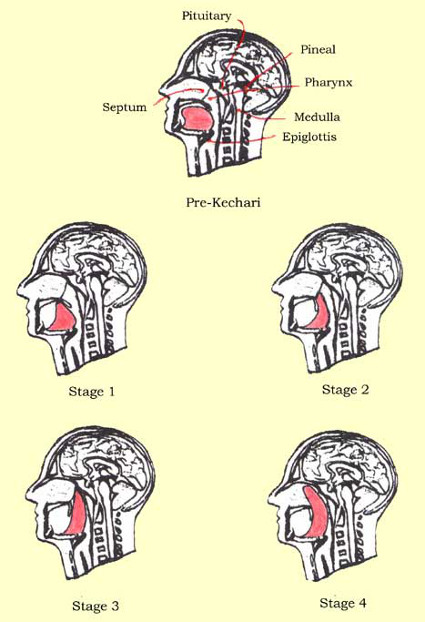
Yogani at AYP site has written the most complete description of Kechari Mudra that I've seen. An excerpt follows, but I highly recommend reading the full lesson.

Lesson 108 - Kechari mudra – A giant leap for humankind
What is kechari mudra? Let's put it in terms that we can easily relate to. A centimeter or two above the roof of our mouth is located one of the most ecstatically sensitive organs in our whole body. It can be reached relatively easily with our tongue. It is located on the back edge of our nasal septum, and when the nervous system is purified enough through advanced yoga practices, our tongue will roll back and go up into the cavity of our nasal pharynx to find the sensitive edge of our septum. When this happens, it is like a master switch is closed in our nervous system, and all of our advanced yoga practices and experiences begin to function on a much higher level. When kechari is entered naturally, we come on to the fast track of yoga. It is the major league of yoga, if you will.
Ramakrishna said, "When the divine goddess comes up, the tongue rolls back."
Many have experienced this natural phenomenon at times in their yoga practices. When the nervous system is ready, it just happens. The tongue wants to go back. But few are able to follow though, and this is just a matter of education. If strong bhakti is there and the tongue is rolling back, it is a short trip to make the connection in the pharynx to a higher level of spiritual experience.
Not many people on earth today have made this important transition in yoga. However, it is likely that the number of people entering kechari will increase dramatically in the coming years. As this happens, it will be a giant leap forward for humankind, for it will mark humanity's shift to a predominantly spiritual mode of functioning of the nervous system. This will bring with it the many benefits of rising enlightenment spreading out through our modern society. Kechari is that significant, that powerful, and that indicative of where the human race is heading. Only a few yogis and yoginis in kechari can have a huge affect on the spiritual energies in everyone. They radiate energy that quickens the rise of the enlightenment process in all. So, while kechari is an individual phenomenon on the road to human spiritual transformation, it has global implications, as do all of our advanced yoga practices. As Jesus said, "You are the light of the world."
Advanced yogis and yoginis use kechari continuously throughout their sitting practices, and often during the day when not engaged in conversation. In other words, kechari is home for the advanced yogi and yogini. We do not even know that they are in kechari. Only the subtle glow of divine light gives them away. Inside, they are in the constant play of divine lovemaking.
We will cover four stages of kechari here (see Image above), all pertaining to the location of the tip of the tongue:
Stage 1 – To the point on the roof of the mouth where the hard and soft palates meet. This is the line of demarcation that must be crossed before stage 2 can be entertained.
Stage 2 – Behind the soft palate and up to the nasal septum. It is a short trip, but a momentous one. Initially this is done with help from a finger pushing back under the tongue, going to the left or right side of the soft palate where entry is easiest. This may require "breaking the hymen" of the membrane under the tongue. See below for more on this.
Stage 3 – Gradually working to the top of the nasal pharynx and septum. This takes us to the bony structure containing the pituitary gland.
Stage 4 – Entering the nasal passages from inside and moving upward beyond the top of the pharynx toward the point between the eyebrows. It is not as far for the tongue to go as it seems. Put your thumb on the hinge of your jaw and put your index finger at the tip of your tongue extended straight out. Then pivot the fixed length to your index finger up on your thumb to the point between your eyebrows. See? It is not so far for the tongue to go straight up from its root.
In these lessons we view the frenum as a tether to be trimmed back when the time is right. It keeps us out of kechari until we are ready. When we are ready, and each of us knows when that is, the frenum can be trimmed. It is like a "hymen." When a woman is ready for sexual intercourse, the hymen goes. Until then it serves to provide protection. This breaking of the hymen can be a stressful and painful event if it is forced. Sooner or later the frenum will be forced open too, because going into kechari is as natural as going into sexual intercourse. It is biologically preordained. It happens when the nervous system is mature enough. Advanced yoga practices bring us closer to the transition with each day of daily practices.
In terms of my own timeline, I started with stage 1 in 2003 but had no interest in moving to stage 2 until 2012, then after about a month of Talabya Kriya I was able to push my tongue with my fingers into stage 2, and I did not have to trim my frenum as Yogani describes. In 2013 I achieved stage 3 and this year (2014) I achieved stage 4 and have begun practicing Nadi Shodhana by using my tongue to block each nasal passage in turn. I generally use stage 3 for the Kundalini Kriyas and Golden Age Kriya.

